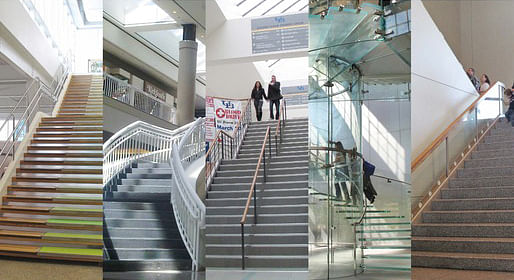
Contemporary Practices in Stairway Design: Behavior of Stair Users in Public Buildings
Contributed By: Karen Kim, M.Arch. Thesis Student
Thesis Committee: Dr. Edward Steinfeld and Dr. Sue Weidemann
------------------------------------------------------------------
Safety is a top priority for building users and should be a primary goal for architects when designing public buildings. Stairway falls continue to be one of the main causes of injuries in buildings, and while research has shown that these incidents are often related to the architectural design of stairways, stair safety remains difficult in practice. This is because knowledge of stairway design and the effectiveness of stair safety standards has been limited or within the profession of architecture. As a result, architects are experimenting with innovative designs that may increase the risk of tripping, slipping and falling on stairs. Steps to closing this knowledge gap and improving stair safety include assessments of design practices, identification of potential risks, and education on applying inclusive design thinking to stairways.
This thesis examined contemporary practices in stairway design and their effects on the behavior of stair users. A review of the professional literature identified innovative stairway design features related to stair safety. Two potentially hazardous features were identified for assessment in the real world: glass stair treads and interactive sound. Observations of stair use were collected at five different stairways in public buildings. The chosen design features were present in three of these stairways, and the other two stairways were constructed in a conventional manner. The incidence of unsafe stair use and key behaviors on the stairways were documented and compared.
The results showed that the glass stairway had incidents at a far higher rate than the conventional stairway. The rate of incidents in the interactive stairways was virtually the same to those in the conventional stairways. The findings suggest that research attention should be given to glass stair treads. Interactive sound needs to be studied in more depth to determine if the perception of hazardous conditions leads to more caution or if the sound features cause people to pay more attention and avoid hazardous behaviour. The research also demonstrates that more assessments of stairway designs in use can help identify best practices and additional gaps in knowledge for the design of stairways.
This thesis provides architects and researchers insights into identifying stairway design hazards and evaluating their effects on stair users. While there are many other issues in the design of stairways that require research attention, this research provides a method to complete further field assessments and offers suggestions for future work on stair safety.
This research has been presented at the 2013 Leadership Exchange in Arts and Disability (LEAD) conference.

Learn more about the research and creative activities of our enterprising students and faculty. At the School of Architecture and Planning, we engage with our local and global communities to push the boundaries of our disciplines and innovate the professions of architecture and planning.
No Comments
Block this user
Are you sure you want to block this user and hide all related comments throughout the site?
Archinect
This is your first comment on Archinect. Your comment will be visible once approved.